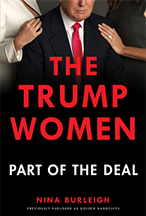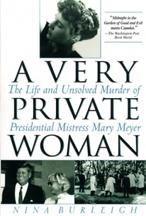
In recent months, the Clinton administration has launched an all-out effort to bring women voters back into the fold. The White House has recently instructed agency heads to offer up one women's event a month where the president might appear; soon it will create a new political outreach office whose sole aim will be to capture the female vote. At a cozy "roundtable" in the Old Executive Office Building earlier this spring, White House liaison Alexis Herman addressed a group of female reporters on what Bill Clinton has done for women. And Hillary Rodham Clinton has emerged from her post-health
reform funk as a born-again feminist, expressing support for women at venues from Lahore to Copenhagen to New York.
As Bill Clinton prepares his reelection bid, a sea change is underway. In a quest to re-ignite the 8 percent female plurality that helped put him over the top in 1992, Clinton strategists are looking away from the angry white male and toward the ambivalent female. As the pixilated standard-bearer for women, Clinton has been a blessing and a curse. The progressive Bill Clinton appears amply willing to promote women's interests, having put more females in political appointments than any president in history. But Bill Clinton the "good ol' boy" seems by his behavior to have an indifferent personal attitude toward females.
For those women closest to Clinton, the evidence is everywhere. Inside the White House, top-level women have been shut out of the inner circle, snubbed and given titles without responsibility. Many have had difficulty doing their job because they aren't kept in the loop. Others complain about the lack
of access they have to Clinton, or of finding out about meetings they should have been in long after they're over.
Female staffers refuse to talk about their experiences, citing loyalty or a desire to remain above the fray. But in the course of covering Clinton from his election through last year, I often heard White House women at dinner tables and in casual conversations venting resentment of the white male clique that has come to dominate Clinton's political coterie. Within the White House, the segregation among men and women is unofficial but obvious nonetheless: Hillary Clinton's staff is made up of mostly women, who effectively operate as a separate unit from the male advisers of her husband.
In the lexicon of the Clinton camp, the women say there are those within the male clique who "get it" and those who "don't get it." Those who "get it" are progressive about women and understand their importance politically. Harold Ickes "really gets it," says pollster Celinda Lake. Leon Panetta doesn't "get
it." "He has a problem with women," said several White House women I spoke with, observing that he seems more comfortable with the role his wife played for decades (as his personal secretary and coffeemaker in Congress) than with women as decision makers.
But the problem existed long before Panetta arrived. Campaign political operative Betsey Wright became the first victim of the dismissive thinking in the Clinton camp that later affected women inside the White House. For a decade, she was Clinton's chief of staff in Arkansas, but her power was quickly ceded to James Carville and George Stephanopoulos during the campaign. She became known as "nuts," or "unbalanced" -- apparently for her crying fits and hard-ball, high-energy behavior in the office. Meanwhile the loony tunes of Carville, who, according to published reports, curled up in a fetal position when Gennifer Flowers came forward, and who was known for wearing a "lucky glove" and weeping openly in the office, are displays of his brilliance.
Clinton's problem with females has been cleverly, if precariously, disguised by the timely promotion of Laura Tyson, the conspicuous presence of female Cabinet secretaries and the conscious effort to replace some departing women with women. But last summer, when the staff changes heralded by Panetta's arrival started, the female staff bore the brunt of the overhaul.
Thus Panetta and others focused on the alleged incompetence or inexperience of former Cabinet secretary Christine Varney or other women such as former scheduler Rikki Seidman, former press secretary Dee Dee Myers, and former political director Joan Baggett rather than on the mistakes of, say,
Stephanopoulos or economic policy adviser Gene Sperling.
Eventually, all of those women left.
In policy matters affecting women, Clinton's record is also ambivalent. He quickly overturned the abortion gag order but has done little to respond forcefully to the growing physical danger faced by abortion clinics, doctors and patients. He started out highly focused on domestic policy -- which pollsters view as a woman-friendly issue. But once in the full swing of governing, Clinton turned to foreign matters -- goaded into his new course partly by the jeers of the male-dominated foreign policy crowd.That effort, and most others Clinton tried, weren't enough to shore up Clinton's support among men, as the November congressional elections proved. So now the administration is trying again to talk the talk it thinks women want to hear. Among its more recently minted plans is one to talk up the benefits that affirmative action has brought to women whenever the opportunity arises.
That Clinton strategists are struggling to attract the female vote should come as no surprise. Ever since Clinton took office, and even during the campaign, women have been at the core of the administration's angst. Speculation about the Clintons' marriage and who really wears the pants has been a constant source of jokes and subsequent analysis. The very notion of the First Lady as professional wife was a political issue, inviting a drumbeat of vicious, below-the-belt attacks. Firing the opening salvo at the 1992 Republican convention, Pat Buchanan said ominously of the Clinton camp, "My friends, this is radical feminism." Petrified of the f-word, the Clinton camp launched on a course of appeasement, beginning with efforts to "tone down" Hillary, which continued until quite recently.
Complicating matters, Clinton's personal life has been one of the most publicly scrutinized in modern memory. In the delicate national political discourse, Paula Jones, Gennifer Flowers and the troopers' allegations are what pundits really mean when they talk about Clinton's "character issue." But always
left unsaid is that the "character issue" has less to do with how the president might react toward Bosnia and much more to do with how he behaves toward females.
How does a man who claims to hold women in high regard explain away what seem to be chauvinistic exploitations of women? Simple: Make the accusers out to be pitiable "bimbos" who, for reasons of politics or money, lie about their relations with the former governor of Arkansas. According to this strategy, conceived by Wright before the inner circle did her in, Clinton maintains his image among professional women by separating off the "bimbos" as spindle-heeled opportunists with big hair.The administration insists most women don't care about Clinton's alleged sexual transgressions and the harassment lawsuit brought by Paula Jones. "I think that there is a segment of women voters where perhaps that is an issue," Herman said to reporters in March. "But in the main I think that women recognize that these are allegations against this president, and I think they are just that, allegations." How women react to Clinton's personal behavior seems to depend in part on their economic position. According to pollster Lake, who tracks women's opinions, women at first distrusted Clinton but they got over it in 1992. College-educated women are far more supportive than non-college women, but noncollege women are part of the swing vote that Clinton needs to attract. For professional women, Hillary Rodham Clinton's mere presence is an implied promise, even while they are disturbed by the alleged behavior of her husband. Lesser educated or older women don't trust Clinton either, or for that matter Paula Jones. But unlike the professional women, this group isn't consoled by the presence of Hillary Clinton in the White House.
Non-professional women -- the receptionists and checkout clerks and the waitresses and housewives -- know what it's like to need a man to get ahead. The truest victims of economic sexism cannot survive without their men. Among that group, many look at Paula Jones and Gennifer Flowers and see women who tried and failed to seduce an easy way out. Tough luck and better luck next time, they think. Hillary Clinton is regarded as a tremendous political asset for the administration in shoring up the professional women's vote. "If you want to get every college-educated woman under 50 who is not a Republican, you send her a letter from Hillary," Lake says.
But the divide-and-conquer strategy has greatly damaged Mrs. Clinton's ability to appeal to the mass of women who fit into the demographics of the "bimbo." And that is no small problem, since there are far more working-class women in this country than there are professionals and managers. Even under normal circumstances, appealing to the two classes of women is not easy, since bimbo-ized women in the secretarial pool are shaped by economics into natural enemies of professional women, a la Sigourney Weaver and Melanie Griffith in "Working Girl."
As part of the ongoing effort to appease the anti-feminists, during the last two years, Mrs. Clinton has tried hard to be all things to all women. She has careened from "look" to "look" and back again. The confusion is easy to trace and it has little to do with her peripatetic personal taste. Pollsters tell her Americans are more "comfortable" with her when she embodies many "roles" -- wife, mother, maybe a little advocacy for a pet issue. Following this strategy, she and her staff have advanced from confusion into wholesale disingenuousness by pointedly doing interviews with gossip columnists and food writers. The strategy will backfire if the public suspects the meticulously crafted Good Housekeeping image is a fraud, as some GOP pollsters believe they do already.
If women are mad at Bill Clinton, the administration is inclined to think it is because of their own economic problems, not because of the way Clinton treats women. The way Clinton's strategists figure it, these women haven't yet felt the effects of an improving economy under Clinton, and they might never feel it since they toil in that sector of the economy where real wages have not risen for decades. Those who blame Clinton for this are merely looking for a scapegoat.
"I talk to women all around the country in all kinds of jobs," the Labor Department's Karen Nussbaum said to a group of reporters recently. "What they do talk to me about is, 'I can't get my pay up. I don't know how I'm going to pay the dentist, my child care is unreliable, my husband lost his job and now I'm responsible for the mortgage and I'm terrified I'm going to lose my job.' Women want practical answers to practical problems and they are far more concerned with that than the allegations."
Bill Clinton will probably redeem himself with women voters by 1996, if for no other reason than there is no one else to turn to in the angry-white-male political funhouse. The White House is wise to stake out its territory now and to remind women how bad things might be without him. Someone inside the White House seems to have finally noticed the futility of efforts to disguise its women's message and fool the anti-feminist crowd. Now it remains to be seen whether women voters will stand by this man.








Leave a comment